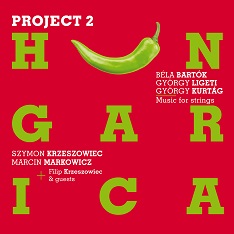Die ungarische Folklore schöpft auch aus der Weite der ehemals österreichisch-ungarischen Monarchie vor dem Ersten Weltkrieg. Alle drei Komponisten dieser Aufnahme wurden in Gebieten geboren, die 1920 im Vertrag von Trianon an Rumänien abgetreten wurden.
Für die Moderne der Musik machte Bartok ungarische Qualitäten wie Farben und formalen Konstruktivismus im engen Kontakt zu Land und Leuten zugänglich. Ligeti nutzt für Ballade und Tanz und die Cellosonate das althergebrachte Modell von zwei schnellen und langsamen Sätzen, die Anklänge an die Duos von Bartok durchschimmern lassen. György Kurtag, der Meister der Miniatur, vertonte Texte von Schriftstellern, die sich mit den dunklen Seiten des Lebens befassen. In Ligatura: Nachricht an Frances-Marie (Die beantwortete unbeantwortete Frage) tritt Kurtág dagegen in einen Dialog mit The Unanswered Question von Charles Ives.
Für diese Auswahl haben sich die beiden polnischen Geiger Szymon Krzeszowiec und Marcin Markowicz zusammen getan. In untadeliger technischer Ausführung bieten sie, selber aus einem Land stammend, in dem die Volksmusik eine wichtige Rolle spielt, die Werke lebendig durchgestaltet an. Bei den als Schulwerken entstandenen 44 Duos von Bartok kann man bei ihrem Spiel vom einfachen Anfang bis zum Ende die immer höheren Anforderungen der Duos gut nachvollziehen. Die anderen, für voll ausgebildete Musiker geschaffenen Stücke, erfahren dann solistischer ausgestaltete Interpretationen.
Die Geiger werden punktuell von den Cellisten Filip und Adam Krzeszowiec sowie Anna Krzeszowiec an der Celesta unterstützt. Auch die Werke in gemischten Besetzungen von Kurtag und Ligeti werden in ausgefeilten Deutungen vorgestellt. Insbesondere gelingt es Filip Krzeszowiec sehr gut, die anspruchsvolle Cellosonate prägnant zu gestalten.
Geradezu vielstimmig präsentiert sich Ligatura von Kurtág mit fünf Stimmen in diesem Kontext.
Hungarian folklore also draws on the vastness of the former Austro-Hungarian monarchy before the First World War. All three composers on this recording were born in areas that were ceded to Romania in the Treaty of Trianon in 1920.
Bartok made Hungarian qualities such as color and formal constructivism accessible for modern music in close contact with the country and its people. For Ballad and Dance and the Cello Sonata, Ligeti uses the traditional model of two fast and slow movements, with echoes of Bartok’s duos shimmering through. György Kurtag, the master of the miniature, set texts by writers dealing with the dark side of life to music. In Ligatura: Message to Frances-Marie (The Answered Unanswered Question), Kurtag enters into a dialog with Charles Ives’ piece The Unanswered Question.
The two Polish violinists Szymon Krzeszowiec and Marcin Markowicz have joined forces for this selection. Coming from a country where folk music plays an important role, they present the works with impeccable technical execution. In Bartok’s 44 duos, which were written as school works, their playing from the simple beginning to the end makes it easy to understand the ever-increasing demands of the duos. The other pieces, created for fully trained musicians, are then given more soloistic interpretations.
The violinists are supported at times by cellists Filip and Adam Krzeszowiec and Anna Krzeszowiec on the celesta. The works in mixed ensembles by Kurtag and Ligeti are also presented in sophisticated interpretations. In particular, Filip Krzeszowiec succeeds very well in shaping the demanding cello sonata concisely. Kurtag’s Ligatura with five voices is almost polyphonic in this context.


















